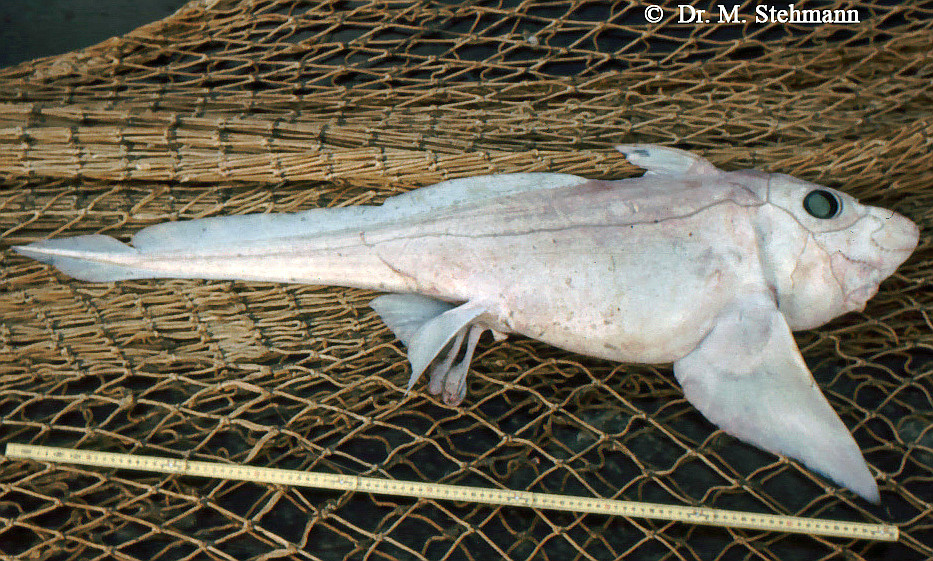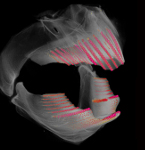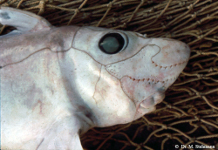Hydrolagus pallidus
Hardy & Stehmann, 1990
Pale ghost shark
Classification: Holocephali Chimaeriformes Chimaeridae
Reference of the original description
A new deep-water ghost shark, Hydrolagus pallidus n. sp. (Holocephali, Chimaeridae), from the Eastern North Atlantic, and redescription of Hydrolagus affinis (Brito Capello, 1867). Archiv für Fischereiwissenschaft, 40(3), 229–248
A new deep-water ghost shark, Hydrolagus pallidus n. sp. (Holocephali, Chimaeridae), from the Eastern North Atlantic, and redescription of Hydrolagus affinis (Brito Capello, 1867). Archiv für Fischereiwissenschaft, 40(3), 229–248
Image of the original description
Image in copyright.
Image in copyright.
Types
Hydrolagus pallidus
Holotype: ZMH: 25389 (old: ISH 33-1981); Paratype: BMNH: 1988.6.28.2; BMNH: 1988.6.28.1; NMNZ: P 22162; NMSZ: 1988. 025. 0001; NMSZ: 1988. 025. 0002; ZMH: 25394 (old ISH: 205-1975); ZMH: 25393 (old ISH: 831-1974); ZMH: 25392 (old ISH: 118-1974a-d); ZMH: 25390 (old ISH: 67-1974); ZMH: 25391 (old ISH: 103-1974);
Hydrolagus pallidus
Holotype: ZMH: 25389 (old: ISH 33-1981); Paratype: BMNH: 1988.6.28.2; BMNH: 1988.6.28.1; NMNZ: P 22162; NMSZ: 1988. 025. 0001; NMSZ: 1988. 025. 0002; ZMH: 25394 (old ISH: 205-1975); ZMH: 25393 (old ISH: 831-1974); ZMH: 25392 (old ISH: 118-1974a-d); ZMH: 25390 (old ISH: 67-1974); ZMH: 25391 (old ISH: 103-1974);
Description :
Citation: Hydrolagus pallidus Hardy & Stehmann, 1990: In: Database of modern sharks, rays and chimaeras, www.shark-references.com, World Wide Web electronic publication, Version 01/2026
Please send your images of "Hydrolagus pallidus" to info@shark-references.com

Hydrolagus pallidus Hardy & Stehmann, 1990, adult, male, length: 740 mm BL, 1107 mm TL, date vessel station: 09.12.1974, "W. Herwig“- Stat. 956/74, location: Great Sole-Bank NW, paratype, ZMH 25393 (old ISH: 831-1974) © Dr. M. Stehmann

Hydrolagus pallidus Hardy & Stehmann, 1990, adult, male, length: 740 mm BL, 1107 mm TL, date vessel station: 09.12.1974, "W. Herwig“- Stat. 956/74, location: Great Sole-Bank NW, paratype, ZMH 25393 (old ISH: 831-1974) © Dr. M. Stehmann
Common names
 Pale ghost shark
Pale ghost shark
 Pale ghost shark
Pale ghost shark
Short Description
Field marks and Diagnostic Features after EBERT & STEHMANN, 2013 [17836]: Field Marks: A very large Hydrolagus with the oral and preopercular lateral line canals either sharing a short common branch or branching together, dorsal–fin spine about equal in height to first dorsal fin, and a very short filamentous tail. Colour is a uniform pale grey to white. Diagnostic Features: Body large, very stout, tapering from large head to short filamentous tail; caudal filament very short with blunt tip. Snout short, bluntly pointed. Eyes relatively small, oval shaped. Lateral line canals on head appear as open grooves, canals on the snout characterized by wide dilations. Preopercular and oral canals either share a short common branch or branch together from the infraorbital canal. Skin not deciduous, typically remains intact. Pectoral fins short, broadly triangular, reaching to pelvic–fin base when laid back. Pelvic fins concave along distal edge and pointed ventrally. Male frontal tenaculum robust, bulbous with numerous sharp, curved hooks on rounded ventral and anterodorsal surfaces; denticles extending onto dorsal surface. Pre-pelvic tenaculum with at least five to six large denticles along medial edge. Pelvic claspers stout with bulbous fleshy tips covered by a shagreen of denticles; divided for the distal one-third of their length, reaching just to distal edge of pelvic fin. Males without postanal pads, females with large postanal pads. First dorsal fin high, triangular, a short fin-base, and a slightly concave posterior margin; fin preceded by a stout spine, about equal to dorsal–fin height, anterior edge smooth, posterior edge smooth in adults, weakly serrated in juveniles. Second dorsal fin long, continuous to upper caudal–fin lobe, and relatively even in height or slightly sloping posteriorly along its length. Caudal fin dorsal and ventral lobes are rounded; dorsal lobe slightly shorter or equal to lower lobe; insertion of ventral caudal lobe posterior to insertion of dorsal caudal lobe. Colour: uniformly pale grey to white, some small scattered darker spots mostly on ventral surface and fins. Juveniles a somewhat darker greyish-brown, but as these chimaeras mature they become lighter, with adults being a pale white.
Field marks and Diagnostic Features after EBERT & STEHMANN, 2013 [17836]: Field Marks: A very large Hydrolagus with the oral and preopercular lateral line canals either sharing a short common branch or branching together, dorsal–fin spine about equal in height to first dorsal fin, and a very short filamentous tail. Colour is a uniform pale grey to white. Diagnostic Features: Body large, very stout, tapering from large head to short filamentous tail; caudal filament very short with blunt tip. Snout short, bluntly pointed. Eyes relatively small, oval shaped. Lateral line canals on head appear as open grooves, canals on the snout characterized by wide dilations. Preopercular and oral canals either share a short common branch or branch together from the infraorbital canal. Skin not deciduous, typically remains intact. Pectoral fins short, broadly triangular, reaching to pelvic–fin base when laid back. Pelvic fins concave along distal edge and pointed ventrally. Male frontal tenaculum robust, bulbous with numerous sharp, curved hooks on rounded ventral and anterodorsal surfaces; denticles extending onto dorsal surface. Pre-pelvic tenaculum with at least five to six large denticles along medial edge. Pelvic claspers stout with bulbous fleshy tips covered by a shagreen of denticles; divided for the distal one-third of their length, reaching just to distal edge of pelvic fin. Males without postanal pads, females with large postanal pads. First dorsal fin high, triangular, a short fin-base, and a slightly concave posterior margin; fin preceded by a stout spine, about equal to dorsal–fin height, anterior edge smooth, posterior edge smooth in adults, weakly serrated in juveniles. Second dorsal fin long, continuous to upper caudal–fin lobe, and relatively even in height or slightly sloping posteriorly along its length. Caudal fin dorsal and ventral lobes are rounded; dorsal lobe slightly shorter or equal to lower lobe; insertion of ventral caudal lobe posterior to insertion of dorsal caudal lobe. Colour: uniformly pale grey to white, some small scattered darker spots mostly on ventral surface and fins. Juveniles a somewhat darker greyish-brown, but as these chimaeras mature they become lighter, with adults being a pale white.
Distribution
Eastern North Atlantic: southern Bay of Biscay to western Scotland within the Rockall Trough (44° to 59° N), Iceland, Greenland and the Mid-Atlantic Ridge, including the Azores.
Western North Atlantic: seamounts off New England, USA; the Bear Seamount (39° 54’N, 67° 26’W) and Welker Seamount (40° 05’N, 68° 30’W).
A record of this species (IZUA-PM 2341) from off Chile by ANDRADE & PEQUEÑO [11324] may in fact be that of another species (see Bustamante et al. 2012, H. cf. trolli [15324]). [17836] Source: www.gbif.org
Eastern North Atlantic: southern Bay of Biscay to western Scotland within the Rockall Trough (44° to 59° N), Iceland, Greenland and the Mid-Atlantic Ridge, including the Azores.
Western North Atlantic: seamounts off New England, USA; the Bear Seamount (39° 54’N, 67° 26’W) and Welker Seamount (40° 05’N, 68° 30’W).
A record of this species (IZUA-PM 2341) from off Chile by ANDRADE & PEQUEÑO [11324] may in fact be that of another species (see Bustamante et al. 2012, H. cf. trolli [15324]). [17836] Source: www.gbif.org
Size / Weight / Age
TL max: 137.6 cm (females) and for 136 cm (males); size at maturity is 73 cm (males) and 77 cm (females) body lengths. Size at birth unknown, the smallest free-swimming individual (male) was a 68 cm total length (42 cm body length). [17836]
TL max: 137.6 cm (females) and for 136 cm (males); size at maturity is 73 cm (males) and 77 cm (females) body lengths. Size at birth unknown, the smallest free-swimming individual (male) was a 68 cm total length (42 cm body length). [17836]
Habitat
bathydemersal; marine; depth range of 1188 to 2075 m, but possibly deeper to 2500 m or more [17836]
bathydemersal; marine; depth range of 1188 to 2075 m, but possibly deeper to 2500 m or more [17836]
Remarks
shark-references Species-ID=3092;
shark-references Species-ID=3092;



















